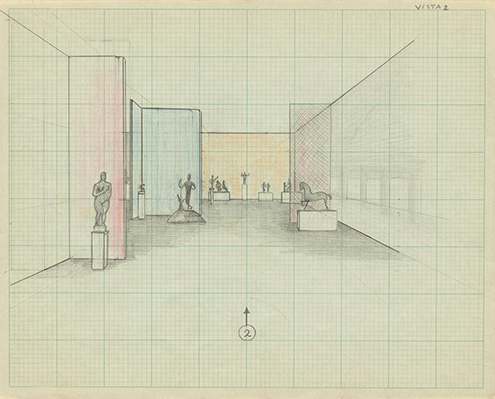CulBeat Express
2018.11.19 18:16
르네 다농코트 MoMA 전 관장과 설치미술 도서 출간
조회 수 596 댓글 0
THE MUSEUM OF MODERN ART ANNOUNCES THE FIRST MAJOR PUBLICATION ON RENÉ D’HARNONCOURT, DIRECTOR OF THE MUSEUM FROM 1949 TO 1968, WHO REVOLUTIONIZED EXHIBITION INSTALLATION METHODS
René d’Harnoncourt and the Art of Installation Presents Rarely Seen Archival Materials,
Including Detailed Preparatory Sketches and Installation Photographs

NEW YORK, November 19, 2018—The Museum of Modern Art is proud to announce the
publication of René d’Harnoncourt and the Art of Installation, the first major volume on the
life and work of René d’Harnoncourt, director of the Museum from 1949 to 1968, who
revolutionized the way art exhibitions are conceived of and mounted. His genius for
installation design and display, documented in elaborate preparatory drawings he created at
each step of his process, guided a methodology that has informed how exhibitions are
organized to this day. Written by Michelle Elligott, Chief of Archives, Library, and Research
Collections at MoMA, the publication delves deep into the Museum’s Archives, including
d’Harnoncourt’s correspondence and hundreds of sketches, to present both a concise
biography of a fascinating figure and a detailed study of his pioneering approach to exhibiting
works of art. The main essay is followed by a portfolio of 13 exhibitions he installed between
1930 and 1968, and a richly illustrated personal chronology.
D’Harnoncourt was a self-taught artist and curator, and René d’Harnoncourt and the Art of
Installation traces his unlikely path to The Museum of Modern Art. Born a count to a
landowning family in Vienna in 1901, d’Harnoncourt trained as a chemist, but when his family
wealth disappeared with the collapse of the Austro-Hungarian Empire in 1925, he set off to
North America and ended up in Mexico, though he spoke neither Spanish nor English. Failing
to find a job as a scientist, he relied on his natural artistic talent to work a variety of odd jobs:
designing posters, sketching bullfights and portraits for tourists, painting pocket-watch faces,
and decorating shop windows for department stores and pharmacies. He soon made contacts
in commerce, seeking out indigenous contemporary traditional crafts and modern art for
galleries and American collectors. This eventually led him to work for the United States Indian
Arts and Crafts Board, and then for Nelson A. Rockefeller in the US State Department. Then, in
1944, he arrived at MoMA, where two new roles were created specifically for him: vicepresident
in charge of foreign activities, and director of its newly formed Department of
Manual Industry. In 1949, he was named director of MoMA, a post he held until his retirement
in 1968. During this same period, with Rockefeller he helped to create the Museum of
Primitive Art.
With his remarkable memory, attention to detail, and draftsmanship skills, d’Harnoncourt
developed a highly sophisticated installation methodology, relying on his extraordinary ability
to juxtapose objects and works of art to bring out contrasting and complementary styles,
relationships, and affinities. He also devoted a keen level of analysis to the visitor’s experience
of art, carefully considering every aspect of its presentation. His interest in non-Western and
non-modern art shaped much of MoMA’s ambitious programming in the mid-20th century: in
addition to shows addressing modern art, such as The Sculpture of Picasso (1968) and
Modern Art in Your Life (1949), he organized exhibitions devoted to themes not generally
associated with MoMA, including Indian Art of the United States (1941), Arts of the South Seas
(1946), Ancient Arts of the Andes (1954), and Art of the Asmat: The Collection of Michael C.
Rockefeller (1962). After retiring from MoMA in 1968, d’Harnoncourt intended to write a book
on museum-installation techniques from his house in Key West, but just two months after
taking his leave, he was struck and killed by an intoxicated driver.
The deeply researched publication examines each aspect of d’Harnoncourt’s multifaceted
installation methodology, and is richly illustrated with reproductions of his drawings and
installation photographs. D’Harnoncourt produced meticulous drawings of every object
included in his exhibitions, first as single objects and then in groupings done to scale. His
approach was to visually link works with cultural and artistic affinities, and arrange them into
vistas that highlighted formal, visual criteria over geographical and historical contexts. He
used lighting and color as symbolic aids, so that visitors could make comparisons while
moving from one section to another. His methodology is further highlighted in the 13
exhibition portfolios included in the book, which present a brief overview of each exhibition
along with detailed information on circulating venues and related publications.
René d’Harnoncourt and the Art of Installation is published by The Museum of Modern Art,
New York, and is available at MoMA stores and online at store.moma.org. 176 pages, 204
illustrations. Hardcover, $45. ISBN: 978-1-63345-050-9. Distributed to the trade through
ARTBOOK|D.A.P. in the United States and Canada and through Thames & Hudson outside the
United States and Canada.
ADVANCE PRAISE
“This handsomely designed and richly illustrated book provides a wonderfully comprehensive
and detailed portrait of an extraordinary man. Michelle Elligott combines a concise biography
of René d’Harnoncourt with a perceptive and nuanced appreciation of his pioneering
approach to exhibiting works of art. The reproductions of d’Harnoncourt’s own masterful
drawings and layout plans are complemented by a dozen superbly illustrated portfolios that
document his most important exhibitions, vividly bearing witness to an especially great period
in the history of The Museum of Modern Art.”
- Jack Flam, President and CEO, Dedalus Foundation, and Distinguished Professor
Emeritus of Art and Art History, City University of New York
“Deeply researched and beautifully presented, Michelle Elligott’s book on Rene d’Harnoncourt
is an important contribution to the literature on The Museum of Modern Art and the
development of contemporary exhibition-making. Documenting d’Harnoncourt’s curatorial
and installation practice through his writings and revelatory drawings, the book gives a
fascinating picture of the life and thought of one of the most important curators and museum
directors of the 20th century.”
- Bruce Altshuler, Director, Program in Museum Studies, New York University






